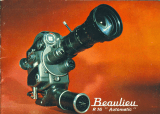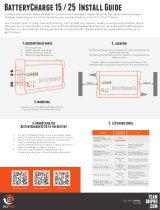Page is loading ...

addendum to the instructions
for the use of the 2008 's

The model in your possession has undergone certain improvements,
to make its use even more practical than before.
Here are the chief differences by comparison with the model described
in the instructions for use.
1
master switch
Now only has three positions: "Auto ", "Manual" (ex - "semi"), and
"Test" (ex-"Control"). These correspond to the following uses:
"AUTO"
To be used if the cine-camera is equipped with a Reglomatic-type lens.
If
so, the switch should be left in this position in practically all cases.
"MANUAL"
To be used when it is desired to cut out the automatic action. Most
oseful when a scene includes zones in which the lighting, being too
highly contrasted, is liable to interfere with cell reactions and thus to
give false exposure values for the subject to be filmed (carefully read
the tips on p. 13). With the Reflex-Control model, you can film as you
please either in the" Auto" or the" Manual" position.
"TEST"
For checking battery charge (see paragraph IV below).

2
use of the pistol grip
The new pistol grip has a three-position switch in the heel of the butt:
A) NORMAL POSITION
The switch plunger is free; at the moment of filming, it must be
depressed with the palm of the hand, thus establishing electric contact.
Then, on pressing the trip button, the camera starts filming (when the
switch is set to "Auto" or "Manual "). To stop shooting, first lift the
finger from the push-button trip; then release the pressure exerted
on the plunger; this breaks the electric circuit.
N.B. -
In no case must the camera's action be stopped by first
releasing the plunger, or the electric circuit will be broken no matter
what the shutter's position. On the contrary, by first r.eleasing the
push-button trip, the camera stops with the shutter closed. thus
avoiding any risk of fogging. The plunger can then be released.
B) SAFETY-CATCH POSITION
This is useful during travel or when the camera is carried by hand.
The plunger being in position A, pull it out slightly (without reaching
the red dot) until the metal pin appears: Press on the broad end of
the pin: this will lock the plunger. To release, press on the smaller
end of the pin.
C) CONTINUOUS ACTION POSITION
For remote-control filming - or for filming oneself. Pull the plunger
out until the red dot appears. Release; permanent electric contact is

established. Block the push-button trip (see page 8), and control the
camera's action either by radio or by means of the cable switch.
When a tripod is used for filming, in position C (frame-by-frame, etc.).
starting and stopping must be controlled with the push-button trip,
either manually or with a release cable.
After shooting, set the plunger back in the normal position (A).
Important note:
Never leave the camera plunger-switch in position
"C" (exceptional use only) when not shooting, or the batteries will be
t
completely discharged. Position "A" or "B" should always be set,
l
I
the battery circuit thus being automatically interrupted.
.1
3
batteries and charging
The camera's source of energy is a battery of cadmium-nickel accu-
mulators, which screws into its housing. It replaces the four separate
accumulator cells mentioned in the instructions for use. Recommen-
dations concerning the handling of these cells (page 16: "Batteries ")
are therefore cancelled.
The advantage of cadmium-nickel batteries lies essentially in the fact ,
that they give a constant p.d., need no maintenance and last practically
'I
for ever. Their
full-charge
operating life is:
I'
• about 10 films at 18 fps between
+
10° and 50°C (50° and 122° F) ~
• about 6 films at 18 fps at -10
0
C (14
0
F)
Charging: use the special Beaulieu charger (see page 15), the pistol-
grip plunger being in position A or B.

TABLE OF NORMAL CHARGING TIMES
I
After shooting
I
Minimum charging time required
2 films
6 hours
4 films
12 hours
6 films
17 hours
8 films
22 hours
10 films
28 hours
Under 5 days, there is no risk of overcharging. When the camera
has not been in use for a month or two, charge for 28 hours.
This cancels the paragraph: "Average charging time ", on page 15.
EXCEPTIONAL CHARGE
Immediately after the camera's purchase, or when the batteries
have not been charged for several months, it is very beneficial to
"retrain" them for normal use in the following manner: charge them
for 24 hours. Then let the camera run, empty, for about 10 minutes.
Then charge again for 12 hours. This method is preferable to using a
long consecutive charging period to put back into shape batteries
which have been left dormant and inadequately charged. In serious
cases, this procedure can be repeated until the batteries are perfectly
"re-educated ", without any risk of overcharging them.
The only reason for this procedure is to allow the batteries to "recu-
perate a normal rvthrn " if they have been long neglected. Once this has
been achieved. resume charging according to normal table charging times.
N.B. -
Special power and charging accessories for use under special
conditions are available. Ask you Beaulieu dealer about them.
I

4
battery-charge check
Set the master switch to "Test". Depress the plunger and look at the
needle in the viewfinder. It should settle above the indicator notch
(if not, the batteries require charging). Wait 20 sees. to ensure a
thorough check. Then return the switch to its initial position. This check
should be carried out periodically. (This paragraph cancels" Battery-
charge check", on p.1).
II

a few useful hints
FOCUSING
1
In order to achieve pinpoint focusing with the ground-glass screen. it is essential to bring
the zoom lens to its" telephoto" position (e.g. for the Anqenieux zoom; 64 rnm] and to
full aperture (f 1.9 for the Anqenieux). Focus the image with the focusing ring. Then
change the focal length as required to frame the picture exactly as desired; the image
will remain in perfect focus.
ZOOM
For focal lengths greater than 30 or 40 rnrn, the use of a tripod is highly advisable, for
otherwise the operator's slightest movements are amplified and, on projection, the picture
will be unsteady. .
As a general rule, always use a tripod when possible; the film's steadiness will invariably
gain by it.
PHOTOCELL
Only shoot when the needle is in the indicator notch. If the light is too poor, use slow
speeds IASA film-speed compensation is built ln) when the subject is not moving.
Some sequences may have to be shot in zones in which light-contrast is strong (beach or
snow scenes, dark shadows ...
l.
When the film subject is in one of these zones (full sunlight
or deep shadow). it is imperative that the cell should only react to the actual lighting in
this zone alone. To achieve this, "zoom" to maximum focal length on the subject. The
cell will react accordingly. Without taking the eye from the viewfinder, set the switch to
"Manual ", so as to block the diaphragm. Then return to the required framing; the central
subject will be properly exposed.

The Beaulieu's range of possibilities allow its owner to cope with practically any shooting
conditions. With a little practice. you will soon be using them to the full.
IMPORTANT
The cell is designed to operate for film-speeds of 100 ASA or less. no matter what running
speed is used. For 200 ASA film. the cell will operate between 50 and 4 fps; for 400 ASA
film. it will operate between 50 and 8 fps.
FILMING SPEEDS
Avoid running the camera empty at speeds in excess of 24 fps. For complete sequences
shot at 2 fps, we advise setting the switch to .. Manual" in order to avoid influencing
cell-response as a 'result of the extremely slow back-and-forth movement of the shutter.
SUPER 8 CARTRIDGES
Super 8 cartridges- are machined to very fine tolerances; their plastic body is however
sensitive to prolonged heat (sunshine. proximity of a fire. etc.). which might cause slight
distortion liable to 'interfere with proper film feed.
Should the film be-blocked during a shoot. remove the cartridge. then put it back into its
housing (N.B, :
the.footaqe
counter will return to zero: see p. 6. paragraph 7) and check
film feed in the viewfinder. If the film remains blocked. check the film's visible perforations.
If
jl
few perforations are damaged. the film can easily be wound on a few frames by
turning the hub clockwise by hand.
These few hints are intended to assist the 2008 S owner's initial steps in amateur
cinematography. They cannot claim to replace existing literature on the subject. intended
for amateurs,
j
j
/







